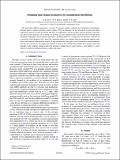Files in this item
Designing spin-channel geometries for entanglement distribution
Item metadata
| dc.contributor.author | Levi, Elliott Kendrick | |
| dc.contributor.author | Kirton, Peter George | |
| dc.contributor.author | Lovett, Brendon William | |
| dc.date.accessioned | 2016-09-12T11:30:20Z | |
| dc.date.available | 2016-09-12T11:30:20Z | |
| dc.date.issued | 2016-09-01 | |
| dc.identifier | 245502925 | |
| dc.identifier | 247393db-3167-49e1-9cd2-d0efea03b44e | |
| dc.identifier | 84989932967 | |
| dc.identifier | 000382794600002 | |
| dc.identifier.citation | Levi , E K , Kirton , P G & Lovett , B W 2016 , ' Designing spin-channel geometries for entanglement distribution ' , Physical Review. A, Atomic, molecular, and optical physics , vol. 94 , no. 3 , 032302 . https://doi.org/10.1103/PhysRevA.94.032302 | en |
| dc.identifier.issn | 1050-2947 | |
| dc.identifier.other | ORCID: /0000-0001-5142-9585/work/47136536 | |
| dc.identifier.uri | https://hdl.handle.net/10023/9477 | |
| dc.description.abstract | We investigate different geometries of spin-1/2 nitrogen impurity channels for distributing entanglement between pairs of remote nitrogen vacancy centers (NVs) in diamond. To go beyond the system size limits imposed by directly solving the master equation, we implement a matrix product operator method to describe the open system dynamics. In so doing, we provide an early demonstration of how the time-evolving block decimation algorithm can be used for answering a problem related to a real physical system that could not be accessed by other methods. For a fixed NV separation there is an interplay between incoherent impurity spin decay and coherent entanglement transfer: Long-transfer-time, few-spin systems experience strong dephasing that can be overcome by increasing the number of spins in the channel. We examine how missing spins and disorder in the coupling strengths affect the dynamics, finding that in some regimes a spin ladder is a more effective conduit for information than a single-spin chain. | |
| dc.format.extent | 6 | |
| dc.format.extent | 492609 | |
| dc.language.iso | eng | |
| dc.relation.ispartof | Physical Review. A, Atomic, molecular, and optical physics | en |
| dc.subject | QC Physics | en |
| dc.subject | TK Electrical engineering. Electronics Nuclear engineering | en |
| dc.subject | DAS | en |
| dc.subject.lcc | QC | en |
| dc.subject.lcc | TK | en |
| dc.title | Designing spin-channel geometries for entanglement distribution | en |
| dc.type | Journal article | en |
| dc.contributor.sponsor | EPSRC | en |
| dc.contributor.institution | University of St Andrews. School of Physics and Astronomy | en |
| dc.contributor.institution | University of St Andrews. Condensed Matter Physics | en |
| dc.identifier.doi | 10.1103/PhysRevA.94.032302 | |
| dc.description.status | Peer reviewed | en |
| dc.identifier.grantnumber | EP/M010910/1 | en |
This item appears in the following Collection(s)
Items in the St Andrews Research Repository are protected by copyright, with all rights reserved, unless otherwise indicated.

